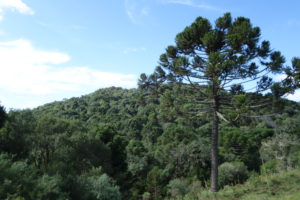Critically-endangered South American forests were man-made
A new manuscript published in Scientific Reports uses a multidisciplinary methodology to explore the relationship between past peoples and the distribution of Araucaria forests in the southern Brazilian highlands.
In the highlands of southern Brazil an anthropogenically driven expansion of forest occurred at the expense of grasslands between 1410 and 900 cal BP, coincident with a period of demographic and cultural change in the region. Previous studies have debated the relative contributions of increasing wetter and warmer climate conditions and human landscape modifications to forest expansion, but generally lacked high resolution proxies to measure these effects. We developed and tested a model of natural ecosystem distribution against vegetation histories, paleoclimate proxies, and the archaeological record to distinguish human from temperature and precipitation impacts on the distribution and expansion of Araucaria forests during the late Holocene. Carbon isotopes from soil profiles confirm that in spite of climatic fluctuations, vegetation was stable and forests were spatially limited to south-facing slopes in the absence of human inputs. In contrast, forest management strategies for the past 1400 years expanded this economically important forest beyond its natural geographic boundaries in areas of dense pre-Columbian occupation, suggesting that landscape modifications were linked to demographic and subsistence changes, the effects of which are still visible today.
Check out the full open access article here
https://www.nature.com/articles/s41598-018-24429-5
See news coverage here
https://www.independent.co.uk/environment/south-america-forest-indigenous-people-chile-brazil-argentina-a8356501.html

